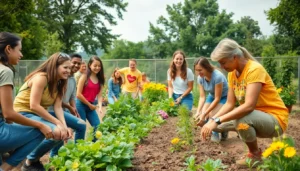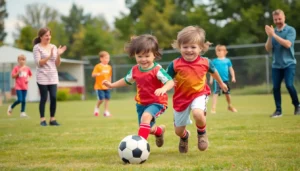Table of Contents
ToggleIn a world where traditional classrooms often feel like a scene from a sitcom gone wrong, alternative education emerges as the quirky hero we didn’t know we needed. Imagine a learning environment where creativity reigns, and the only thing getting tested is how to think outside the box—literally. Alternative education isn’t just a buzzword; it’s a movement that embraces diverse learning styles and unconventional methods, making education more accessible and enjoyable for everyone.
Understanding Alternative Education Meaning
Alternative education encompasses varied educational approaches that deviate from traditional, conventional methods. This form of learning prioritizes individual needs and diverse learning styles. Schools and programs adopting alternative education often emphasize creativity, critical thinking, and practical skills.
Learners engage with the material in ways that resonate with them, leading to a more personalized educational experience. For instance, hands-on activities and project-based learning make concepts tangible and relatable. Many alternative education models incorporate community involvement, allowing students to apply their knowledge in real-world contexts.
Types of alternative education include Montessori, Waldorf, and homeschooling. Montessori programs foster independence through self-directed learning. Waldorf education integrates arts and academics, encouraging holistic development. In contrast, homeschooling provides a tailored environment where parents facilitate learning.
Students exposed to alternative education often exhibit increased motivation and a stronger sense of agency in their educational journeys. The flexibility within these systems can lead to mastery of subjects at a pace that suits each learner. This individualized support promotes not just academic success but also personal growth.
Research supports the efficacy of alternative education methods. Studies have shown that these approaches can lead to improved academic performance and enhanced social skills. Furthermore, alternative education often cultivates an environment where students feel safe to express themselves and explore their interests.
Understanding alternative education’s meaning reveals its potential to democratize learning and make it more inclusive. Through this innovative lens, education transforms into a dynamic experience that empowers individuals and honors diverse capacities.
Historical Context of Alternative Education
Alternative education has roots that stretch back to several early movements, advocating for educational reform. Early movements, such as the Progressive Education movement in the early 20th century, focused on experiential learning. Philosophy-based educators like John Dewey emphasized the importance of teaching through experience rather than rote memorization. The Montessori method, introduced by Maria Montessori, emerged during this time, promoting self-directed learning and respect for a child’s natural development. Waldorf education, founded by Rudolf Steiner, highlighted the development of creativity and critical thinking skills. These approaches laid the groundwork for a shift toward learner-centered education.
Early Movements
Alternative education began transforming pedagogical practices with various early movements. The influence of the Progressive Education movement in the early 1900s centered on the learner’s experience and real-world applications, disrupting traditional models. Montessori education emerged in Italy around the same time, focusing on hands-on activities that fostered independence and growth. Waldorf education, founded in 1919, aimed to cultivate creativity and holistic development through arts and crafts. Each movement contributed significantly to recognizing the importance of individualized learning and the needs of the whole child, which remain central to alternative education today.
Key Figures and Influences
Several key figures and influences shaped the landscape of alternative education. John Dewey played a pivotal role in advocating for experiential learning and the integration of democracy into education. Maria Montessori introduced methods encouraging child-led exploration, thereby changing classroom dynamics. Rudolf Steiner’s Waldorf approach underscored the creative and intellectual development of children through a narrative-driven curriculum. Modern advocates, like Sir Ken Robinson, continue to challenge conventional practices and promote creativity in learning. Each of these influential educators contributed unique perspectives that strengthened the foundation of alternative education, making it more accessible and relevant.
Various Approaches to Alternative Education
Alternative education incorporates several methodologies, each promoting unique learning experiences. Each approach emphasizes the individualized nature of learning, fostering creativity and critical thinking.
Montessori Method
Montessori education focuses on child-led exploration. Students engage with materials that spark their natural curiosity. Guided by teachers who act as facilitators, learners progress at their own pace. Classrooms contain mixed-age groups, allowing younger and older students to collaborate and support each other. This method nurtures independence and self-discipline, ultimately leading to higher academic performance. Research shows that Montessori students often outperform peers in traditional settings on standardized tests.
Waldorf Education
Waldorf education highlights the importance of imagination and creativity in learning. A strong focus on arts, music, and hands-on activities complements academic subjects. Teachers guide students through a developmental approach, aligning lessons with the children’s cognitive and emotional growth stages. Storytelling, drama, and crafts play integral roles in this pedagogical method, enhancing engagement and retention. Empirical studies indicate that Waldorf students exhibit strong social skills and creativity, benefiting from a holistic educational experience.
Unschooling
Unschooling advocates for learning through life experiences and personal interests. This learner-centered approach allows students to pursue topics that ignite their passion. Parents often facilitate this process by providing resources and support rather than traditional curricula. Unschoolers frequently explore diverse subjects, gaining knowledge in real-world contexts. Many proponents believe that this method fosters intrinsic motivation and lifelong learning habits. Research suggests that unschooling can lead to successful adult outcomes, including entrepreneurship and higher education achievements.
Benefits of Alternative Education
Alternative education offers numerous advantages that enhance the learning experience. These benefits include personalized learning and flexibility, among others.
Personalized Learning
Personalized learning stands out as a core benefit of alternative education. Students engage with materials tailored to their individual needs and interests. This approach often results in deeper understanding and retention of concepts. Small class sizes or one-on-one instruction enable educators to focus on each learner’s strengths and weaknesses. Learners can progress at their pace, eliminating the pressure of fitting into a standardized curriculum. Furthermore, project-based activities foster critical thinking and creativity, allowing students to apply knowledge in real-world scenarios. Research consistently shows that personalized learning boosts academic achievement, particularly for students who struggle in traditional settings.
Flexibility and Freedom
Flexibility and freedom represent significant advantages of alternative education. Learners experience greater autonomy in choosing topics that interest them. This freedom enhances motivation and leads to a more engaged learner. Alternative education also allows for diverse learning environments, including outdoor classrooms and home settings. Students participate in hands-on activities that reinforce theoretical concepts, making learning more relevant. Flexible schedules accommodate various lifestyles, allowing for extended breaks or family time. Ultimately, this structure promotes self-directed exploration, fostering lifelong learning habits well beyond the classroom.
Challenges in Alternative Education
Alternative education faces several challenges that can hinder its effectiveness. These challenges manifest in various forms, such as resource allocation and societal perceptions.
Resources and Accessibility
Limited resources often restrict the growth and development of alternative education programs. Many institutions rely on community support, which can vary in availability and reliability. Lack of funding impacts the quality of materials, facilities, and trained staff. Some families may find it difficult to access alternative education options due to financial constraints. Urban and rural settings also experience disparities in resource availability, making accessibility uneven. Furthermore, inadequate awareness among parents and educators diminishes the reach of alternative education models. Diverse educational opportunities appeal to many, but without sufficient support, their potential remains unfulfilled.
Social Perceptions
Social perceptions play a significant role in shaping the landscape of alternative education. Misunderstandings about its legitimacy contribute to skepticism among some educators and parents. Alternative education can be viewed as unconventional or inferior to traditional schooling. Residual stigma surrounding non-traditional educational methods affects how students and families engage with these options. While many advocates celebrate the benefits of projects-based learning and personalized methods, skepticism can prevent broader acceptance. A lack of familiarity leads some to underestimate the effectiveness of alternative approaches. Challenging these perceptions is crucial for fostering a more inclusive view of education that values all learning styles.
Alternative education represents a transformative shift in the way learning is approached. By prioritizing individual needs and creativity, it fosters an environment where students can thrive. The diversity of methodologies ensures that each learner can engage with material in a way that resonates with them.
As awareness of alternative education grows, so does its potential to reshape the educational landscape. Embracing these innovative approaches can lead to a more inclusive system that values all learning styles. By challenging traditional perceptions and advocating for broader access, society can unlock the full benefits of alternative education for future generations.






